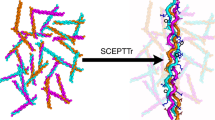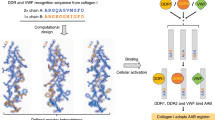Abstract
AN arrangement of three non-coaxial helical chains linked to one another by hydrogen bonds approximately perpendicular to the length of the chains was suggested as the basis of the structure of collagen two years ago1. This structure explained the occurrence of a fraction of more than one-third of glycine residues and could readily accommodate proline and hydroxyproline residues, besides explaining the infra-red dichroism. The exact nature of the helices (namely, three residues per turn) was later found not to be quite correct for collagen, the X-ray pattern of stretched collagen2 indicating the occurrence of 3 residues per turn3. The presence of such a non-integral number of residues per turn required that the three chains must all be further coiled around. The coiled-coil structure4 retained the essential features of the earlier one as regards the location of amino-acid residues and the orientation of the NH- and CO-bonds. However, it is interesting to note that the simpler non-coiled-coil structure has been found to be the basis of the arrangement of polypeptide chains in polyproline5 and in polyglycine II 6. Thus, it appears that the triple chain structure, with minor modifications, is a configuration which might be found also in other proteins and polypeptides. There is, in fact, good evidence to show that elastin belongs to this type7.
This is a preview of subscription content, access via your institution
Access options
Subscribe to this journal
Receive 51 print issues and online access
$199.00 per year
only $3.90 per issue
Buy this article
- Purchase on Springer Link
- Instant access to full article PDF
Prices may be subject to local taxes which are calculated during checkout
Similar content being viewed by others
References
Ramachandran, G. N., and Kartha, G., Nature, 174, 269 (1954).
Cowan, P. M., North, A. C. T., and Randall, J. T., “Nature and Structure of Collagen”, 241 (Butterworths, 1953).
Ramachandran, G. N., and Ambady, G. K., Curr. Sci., 23, 349 (1954).
Ramachandran, G. N., and Kartha, G., Nature, 176, 593 (1955).
Cowan, P. M., and McGavin, S., Nature, 176, 501 (1955).
Crick, F. H. C., and Rich, A., Nature, 176, 780 (1955).
Ramachandran, G. N., and Santhanam, M. S., Science (in the press).
Rich, A., and Crick, F. H. C., Nature, 176, 915 (1955).
Cowan, P. M., McGavin, S., and North, A. C. T., Nature, 176, 1062 (1955).
Ramachandran, G. N., and Kartha, G., Proc. Ind. Acad. Sci., A, 42, 215 (1955).
Schroeder, W. A., Kay, L. M., LaGette, J., Honnen, L., and Green, F. C., J. Amer. Chem. Soc., 76, 3556 (1954).
Kroner, T. D., Tabroff, W., and McGarr, J. J., J. Amer. Chem. Soc., 77, 3356 (1955).
Author information
Authors and Affiliations
Rights and permissions
About this article
Cite this article
RAMACHANDRAN, G. Structure of Collagen. Nature 177, 710–711 (1956). https://doi.org/10.1038/177710b0
Issue Date:
DOI: https://doi.org/10.1038/177710b0
This article is cited by
-
Developments for collagen hydrolysates as a multifunctional antioxidant in biomedical domains
Collagen and Leather (2023)
-
The Madras Group and the structure of collagen
Proceedings / Indian Academy of Sciences (1999)
-
Phase transition of collagen and gelatin
Kolloid-Zeitschrift & Zeitschrift für Polymere (1964)
-
A histochemical study of the proteins of precollagen fibers in regenerating connective tissue
Bulletin of Experimental Biology and Medicine (1963)
-
Studies on collagen
Proceedings of the Indian Academy of Sciences - Section A (1959)
Comments
By submitting a comment you agree to abide by our Terms and Community Guidelines. If you find something abusive or that does not comply with our terms or guidelines please flag it as inappropriate.



